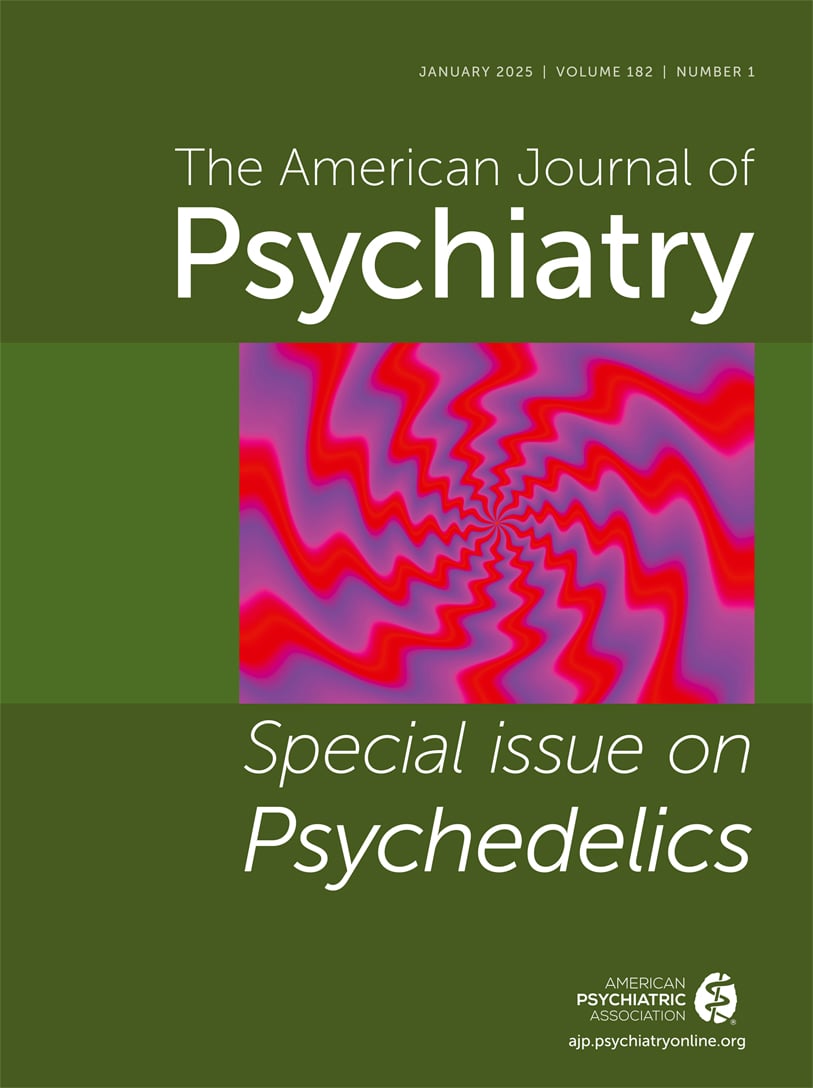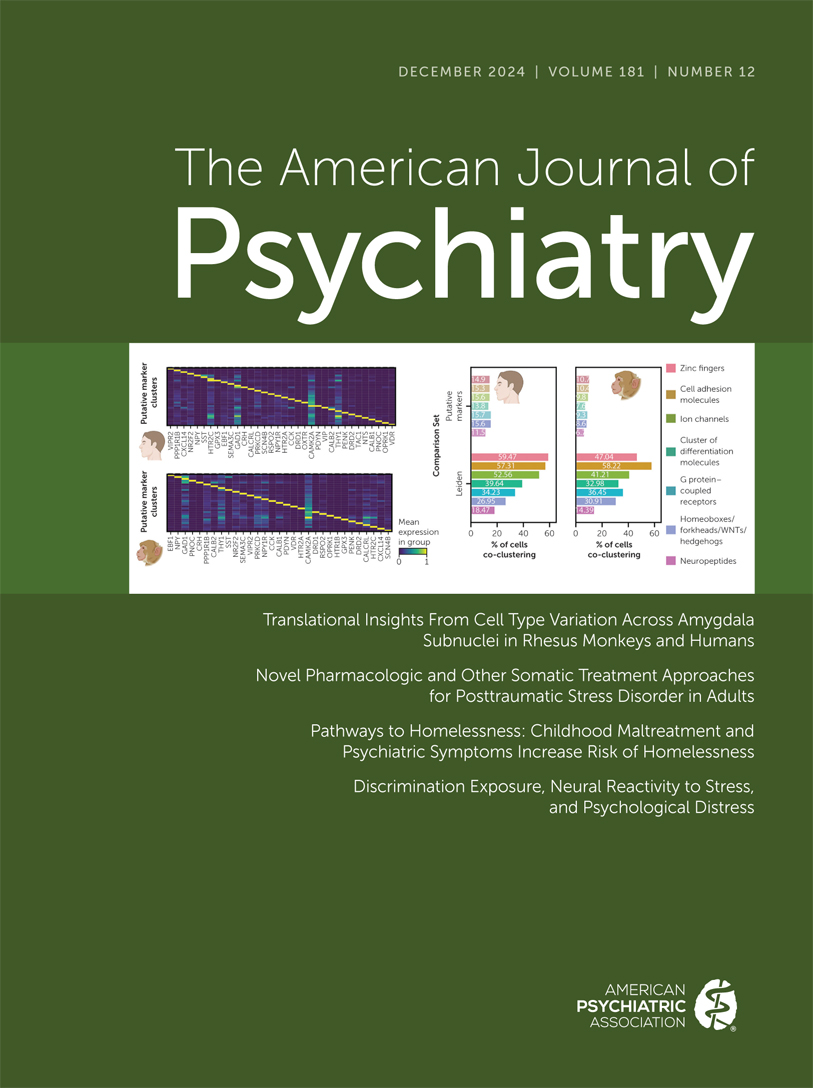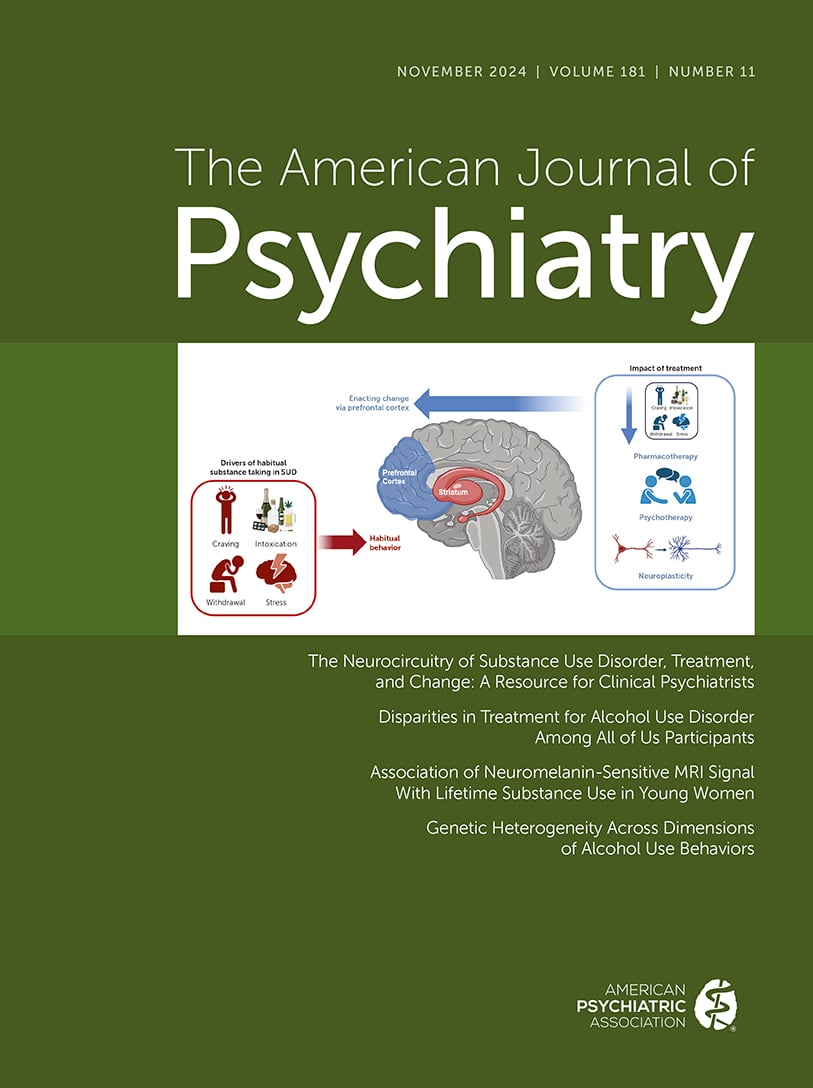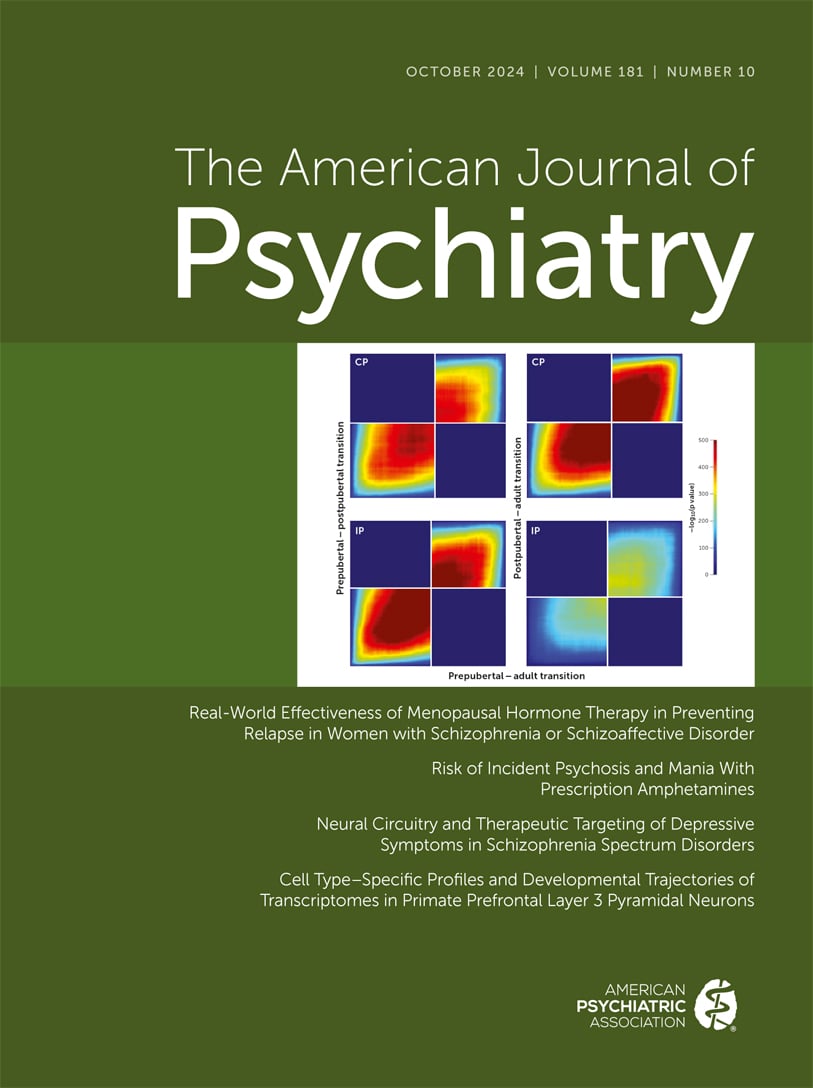American Journal of Psychiatry
- Volume 143
- Number 5
- May 1986
Publication date: 01 May 1986
Pages561–572A previously unpublished paper by a dying psychotherapist describes the therapeutic use of the ensuing grief reactions of five patients to his terminal illness to help them deal with the effects of their previous losses, deprivations, and abandonments. ...
https://doi.org/10.1176/ajp.143.5.561Publication date: 01 May 1986
Pages573–581The author reviews recent advances in the treatment of anorexia nervosa. In addition to the usual areas of weight restoration and psychotherapy, he focuses on difficult issues such as how to engage the patient in treatment, the evaluation of the patient, ...
https://doi.org/10.1176/ajp.143.5.573Publication date: 01 May 1986
Pages582–589This report provides data on symptom levels by using group means as well as categories of clinical relevance as they change over the course of treatment and also examines change "beyond symptoms" as levels of adaptive functioning. This approach allows a ...
https://doi.org/10.1176/ajp.143.5.582Publication date: 01 May 1986
Pages590–595Following the 1980 Mount St. Helens volcanic eruption, psychiatric reactions were studied in the disaster area and in a control community. Using the new criterion-based diagnostic method for psychiatric epidemiologic research, the Diagnostic Interview ...
https://doi.org/10.1176/ajp.143.5.590Publication date: 01 May 1986
Pages596–601The authors evaluated the effects on memory of ECT given with either unilateral or bilateral electrode placement and with brief-pulse or sine-wave stimulus waveform. Clinical criteria determined the mode of ECT and the treatment parameters. As expected, ...
https://doi.org/10.1176/ajp.143.5.596Publication date: 01 May 1986
Pages602–607The authors compared bilateral recordings of electrodermal activity and conjugate lateral eye movements in two groups (10 men and 10 women each) of college students: high-risk nonpatients with subsyndromal depression and normal control subjects. Like ...
https://doi.org/10.1176/ajp.143.5.602Publication date: 01 May 1986
Pages608–613A growing awareness of posttraumatic stress disorder has led to recent use of the disorder as a legal defense against criminal responsibility for both violent and nonviolent crimes. Diagnosis of posttraumatic stress disorder is difficult because the ...
https://doi.org/10.1176/ajp.143.5.608Publication date: 01 May 1986
Pages613–617The authors examined the effectiveness of the prevailing treatment doctrine stressing the principles of proximity, immediacy, and expectancy for combat stress reaction among Israeli soldiers in the Lebanon War. Two treatment outcomes were measured: return ...
https://doi.org/10.1176/ajp.143.5.613Publication date: 01 May 1986
Pages618–621Forty years after the end of World War II, the authors compared a random sample of former Japanese-held Australian prisoners of war (POWs) with a group of non-POW combatants of the same era. The POWs were significantly more depressed than were the control ...
https://doi.org/10.1176/ajp.143.5.618Publication date: 01 May 1986
Pages622–624Diagnosis-related groups (DRGs) are under consideration as a way to pay hospitals for psychiatric care. Yet psychiatric DRGs account for only 3% of the variation in how long patients stay in the hospital. This nearly random variation means that ...
https://doi.org/10.1176/ajp.143.5.622Article
Publication date: 01 May 1986
Pages626–629A structured interview that identified 78 female psychiatric outpatients as having Briquet's syndrome also indicated that 77 of the 78 fulfilled inclusive diagnostic criteria for one or more other psychiatric syndromes. If, as this finding suggests, ...
https://doi.org/10.1176/ajp.143.5.626Publication date: 01 May 1986
Pages630–632The author compared 32 patients who had generalized anxiety disorders with 29 patients who had panic disorder and agoraphobia with panic attacks. He observed that patients with generalized anxiety disorder more often had lost their fathers and/or mothers ...
https://doi.org/10.1176/ajp.143.5.630Publication date: 01 May 1986
Pages633–636Thyroid function abnormalities are common in persons with rapid-cycling bipolar affective illness. Some women who cycle rapidly respond to thyroxine, but there is scant evidence that the people who have thyroid abnormalities are the ones who respond to ...
https://doi.org/10.1176/ajp.143.5.633Publication date: 01 May 1986
Pages637–640Over 27,000 reports about women abused by their live-in male partners were provided by 23 shelter organizations in five locations in the United States. Cosinor analyses revealed statistically significant annual rhythms in the frequencies of abuse, with ...
https://doi.org/10.1176/ajp.143.5.637Publication date: 01 May 1986
Pages641–643Six to 140 months after completion of chemotherapy, 63% of 60 Hodgkin's disease survivors experienced anticipatory nausea, 80% had anxiety, and 5% reported vomiting. Time since treatment and treatment severity were significantly associated with ...
https://doi.org/10.1176/ajp.143.5.641Publication date: 01 May 1986
Pages643–645The authors describe three patients whose panic disorder began during recreational use of cocaine and continued autonomously even after the drug was stopped. Theoretical and practical implications are discussed.
https://doi.org/10.1176/ajp.143.5.643Publication date: 01 May 1986
Pages646–648Intravenous sodium lactate was given to seven patients with primary depression and secondary panic attacks and 26 patients with panic disorder or agoraphobia with panic attacks. The two groups had similar rates of panic response. These results challenge ...
https://doi.org/10.1176/ajp.143.5.646Publication date: 01 May 1986
Pages648–649Among 350 referrals to a neurology service, 19 (5%) had panic attacks manifesting as focal neurologic symptoms. Diagnostic clues included multiple symptoms, normal results on neurologic examination, personal stress, dietary extremes, age 20-50 years, and ...
https://doi.org/10.1176/ajp.143.5.648Publication date: 01 May 1986
Pages650–651Seven psychotic patients' plasma haloperidol levels, determined with gas-liquid chromatography, fell a mean of 60% when carbamazepine treatment was instituted. Two patients' levels became undetectable, and their symptoms worsened. Haloperidol level ...
https://doi.org/10.1176/ajp.143.5.650Publication date: 01 May 1986
Pages652–653Two patients treated with alprazolam for panic disorder and agoraphobia developed a manic episode. Two biological markers--shortened REM latency and nonsuppression on the dexamethasone suppression test-- suggested that both patients may have had an ...
https://doi.org/10.1176/ajp.143.5.652Publication date: 01 May 1986
Pages654–655To investigate whether hypoglycemia might trigger panic attacks, the authors administered intravenous insulin to 10 patients with panic disorder. All subjects developed hypoglycemia but no panic anxiety. They reported symptoms of adrenergic hyperactivity ...
https://doi.org/10.1176/ajp.143.5.654Publication date: 01 May 1986
Pages656–657Among 266 chronic inpatients receiving neuroleptics, six of the 137 (4.4%) receiving neuroleptics alone and none of the 129 receiving concomitant anticholinergics manifested the rabbit syndrome. Procyclidine resolved the signs of all affected patients. ...
https://doi.org/10.1176/ajp.143.5.656Publication date: 01 May 1986
Pages658–660Skin fibroblasts of five subjects with affective illness and two control subjects were examined for muscarinic receptors. Contrary to recent findings, there were low levels of muscarinic binding sites and no evidence that these sites mediate a biological ...
https://doi.org/10.1176/ajp.143.5.658Article
Article
Article
Article
Article
Article
Article
Article
Article
Article
Publication date: 01 May 1986
Pages686-a–686In the letter to the Editor "Side Effects of the New Antidepressants" from Jeffrey A. Mattes in the February 1986 issue (p. 261), the name of co-author David Harwood, B.S., was inadvertently omitted. The staff regrets this error.
https://doi.org/10.1176/ajp.143.5.686-aPast Issues
View Issues Archive
Vol. 182 | No. 1

Vol. 181 | No. 12

Vol. 181 | No. 11
